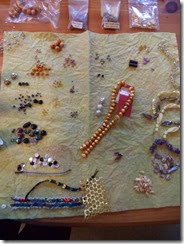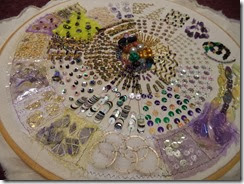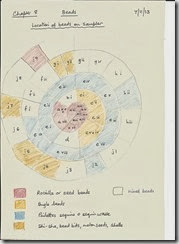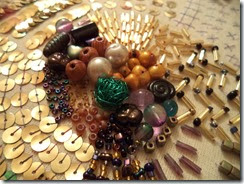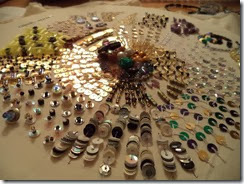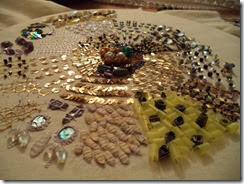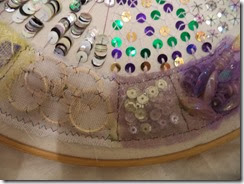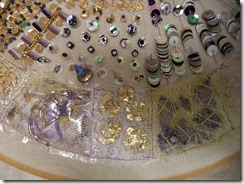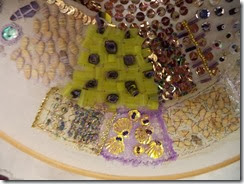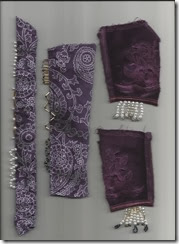This chapter shows the different types of beads that can be used in embroidery. Complementary colours of purple and yellow were selected.
A special bead needle is used where beads have very small holes. It is useful to also use special bead thread which is waxed using special beading wax. I used the bead needle in most instances with a crewel needle where beads were larger. I found using fine threads it was not always necessary to wax the thread.
- Selection of beads
- Sampler showing methods of application
- Samples showing different edgings
- Trapped beads (see Section 2)
1. Selection of beads
In clockwise direction from top left are:
Rocaille or seed beads
Bugle beads
Pearl beads
Shi sha: seeds and shells
Pailettes or sequins and sequin waste
2. Sampler showing methods of application
Based on the spiral theme I chose a sampler arranged as a spiral. I used a large embroidery hoop, 30 cm diameter.
The background fabric is calico backed with muslin for strength not dyed so that the colour from the beads could be clearly seen.
To identify the beads and application techniques I drew a chart with accompanying spreadsheet (the chart shows lower case letters with roman numerals, whereas the spreadsheet gives equivalent coding using capital letter with numbers)
Sampler of bead types and different methods of application
Ref Needlework School pp 124-125
Used beading needle where fine beads and fine thread, crewel needle used otherwise
N B Lower case letters replaced with capitals
Roman numerals with numbers
Area
Bead type
Method of application
Comments
A 1
Rocaille or seed beads
One stitch, individually
Made bead rolling metal wire
A 2
Rocaille 2 pearl beads
One stitch, individually
Worked mostly right to left when attaching A beads
A 3
Rocaille 3 wooden beads
One stitch, individually
Most beads in A were stitched taking needle down
A 4
Rocaille 4 wood glass beads
One stitch, individually
through the same hole as came up
A 5
Rocaille 4 freshwater pearls
One stitch, individually
A 6
Rocaille 6 metallic glass beads
One stitch, individually
See also B 1
A 7
Rocaille several coloured beads
One stitch, individually
Scattered haphazardly
A 8
Rocaille several dark topaz
One stitch, individually
Scattered with spaces
A 9
Rocaille golden yellow glass beads
One stitch, individually
Scattered more widely spaced
A 10
Rocaille tiny variegated beads
One stitch, individually
Close together
B 1
Mixed shapes
One stitch, individually
The larger shapes make the stitch longer
C 1
Bugle beads
One stitch, individually
Fanned lines
C 2
Bugle beads
One stitch, individually
Scattered haphazardly
C 3
Bugle beads and another
One stitch, individually
Zig zag pattern following spiral
C 4
Bugle beads
Varying length strings
In ones, threes and fours, fanned lines
C 5
Two stitch, individually
To keep holes uppermost on single beads
D 1
Rocaille Mixed shapes and colours
Varying length strings
Fanned lines
E 1
Pailettes or sequins
Single back stitch
Fanned lines, sequins touching
E 2
Pailettes or sequins
Two stitch back stitch
Following spiral
E 3
Pailettes or sequins
One stitch, individually
Invisible sequin stitch, in rows
E 4
Pailettes or sequins
Three thread tripod
Used fly stitch
E 5
Pailettes or sequins
Four thread
Square sequins, close and random
E 6
Pailettes or sequins
Six thread
Hexagonal sequins, scattered mixed concave and convex
E 7
Pailettes or sequins
Decorative embroidery stitch
Round sequins Fly and chain stitch
E 8
Pailettes or sequins
Long thread varying lengths
Variety of sequins in fanned lines using long stitch.
Love the moement as beads slide along
E 9
Mixed beads stacked
Rocaille beads on top
Good variety of texture
Single or gathered back through initial hole
F 1
Variety of beads
Compact area, different stitches
Parallel lines in a pattern
F 2
Variety of beads
Compact area, one stitch
Sequins close together, interspersed with tiny beads
Complementary colours in design
F 3
Variety of beads
One and two stitch, individually
Pattern of made beads, straws and rolled. Deeper texture
G 1
Shi sha – melon seeds
Three thread spiral wrap
Seeds have a mind of their own Needed extra chiffon cover
to hold in place. Laid out in spiral but not very clear
G 2
Shi sha – beads and shells no holes
Variety of techniques
Basic Shi sha frame for shells
G 3
Sequin waste
Three and Four thread
Like the haphazard effect using metallic variegated thread to attach
the sequin waste
G 4
Sequin waste
Two thread zig zag stitch
At each corner attached a bead which provides a pattern centred on
some of the holes and attaches the sequin waste
H 1
Roughly cut semi precious beads
Couched threads of beads
Used two threads and two needles, the second couching the thread
in a snake-like spiral pattern
H 2
Pailettes or sequins ready made strings
Couched threads of beads
Used one needle with hidden thread, arranged in spiral patterns
H 3
Mixed beads on a string with no holes
Couched threads of beads
Tried to vary the couching mixing location of couch and stitch using
three different arrangements
J 1
Mixed beads cut from string
Trapped beads with chiffon
Running stitch between the beads to help keep in place
J 2
Pailettes or sequins
Trapped beads with organza
Lovely glittery raised surface
J 3
Hoops
Trapped beads with muslin
Pattern generated by stitching around each hoop through the cover
J 4
Shi sha – shells no holes
Trapped beads with dyed scrim
Held in place using varied size in fly stitch
J 5
Shi sha – spirals cut from tomato puree tube
Trapped beads with net
To space used running stitch to follow spirals, made extra in spaces
H & S puree tube can be sharp once cut, the net gives some protection
J 6
Pailettes or sequins
Trapped thread bits with plastic
Useful way of using complementary coloured bits of thread.
Added a couched spiral of beads for extra texture
J 7
Shi sha – melon seeds
Trapped beads with net
Cross stitch in variegated metallic thread used to attach the seeds.
Running stitch between the beads. Kept in place better than G 1
J 8
Pailettes or sequins – shells with holes
Trapped beads with dyed scrim
Fancy bead help place the sequins. Zig zag used to attach scrim
works as well as back stitch
J 9
Rocaille or seed beads
Trapped beads with ribbon
Zig zag lines separated some of the beads, clustered in different
quantities. Glittery and decorative
Hand stitching was used throughout, although could have used machine stitching especially to attach fabrics trapping beads.
Made the pockets before adding the beads. Machining would have meant removing the sampler and turning it over so I could stitch into the fabric.
Decided it was easier to use hand stitching. In other layouts may be easier to rearrange the fabric for the machine.
3. Samples showing different edgings
The next illustration shows different ways of edging with beads
The first strip shows (from top to bottom): rocaille beads individually along a seam; close together then spaced using a bugle bead and the third as small strings of five beads ( the last gives a spiral effect as each strand has been sewn from back to front onto the seam, rather than just stitching along the seam)
The second strip shows (from top to bottom): individual bugle beads separated with a seed bead, each is stitched on to the seam returning through the previous bugle bead repeating along the length of the seam; similar sequence but giving a zig zag arrangement (not returning through the bugle bead); the third a varied colour of beads showing the effect of stitching along the seam
The top right and bottom right samples show fringes where the bead needle returns through each strand except for last bead to attach to the seam. The bottom right example shows how a pattern can be developed by rearranging the sequence of beads. At the end of each string is a single or loop of beads.
It was a helpful exercise and I feel I have learnt a lot about different beads and manipulating them. The sampler will remain a useful guide to the different beads and their applications
